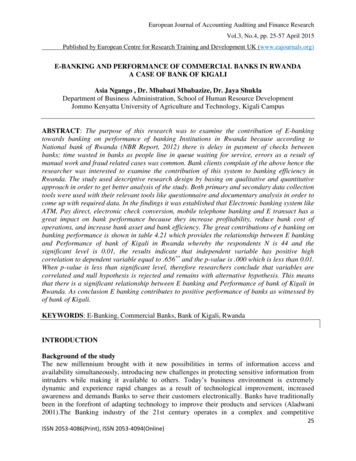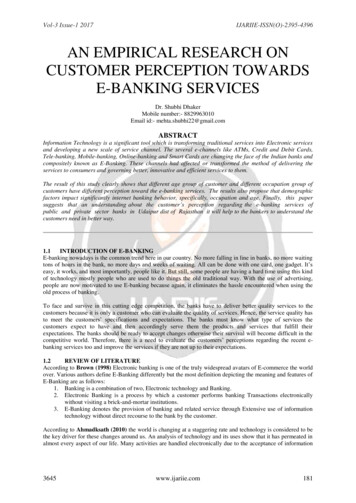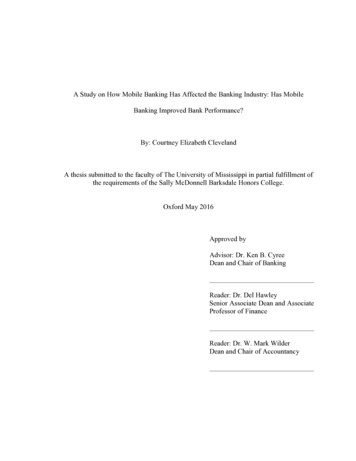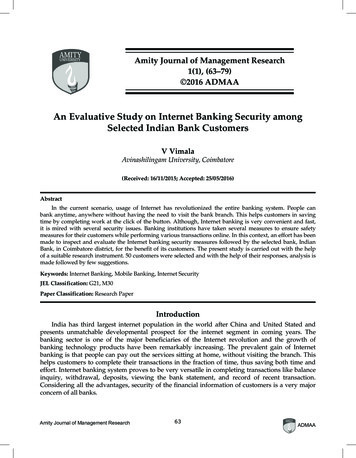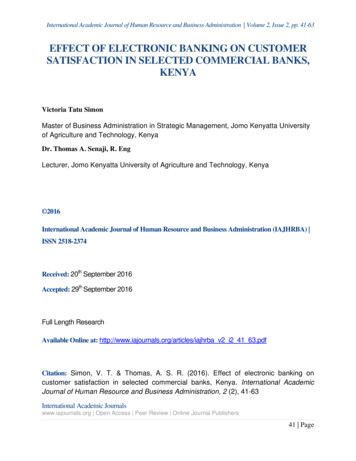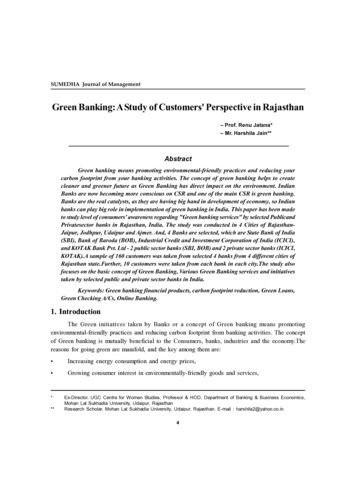
Transcription
SUMEDHA Journal of ManagementGreen Banking: A Study of Customers' Perspective in Rajasthan– Prof. Renu Jatana*– Mr. Harshila Jain**AbstractGreen banking means promoting environmental-friendly practices and reducing yourcarbon footprint from your banking activities. The concept of green banking helps to createcleaner and greener future as Green Banking has direct impact on the environment. IndianBanks are now becoming more conscious on CSR and one of the main CSR is green banking.Banks are the real catalysts, as they are having big hand in development of economy, so Indianbanks can play big role in implementation of green banking in India. This paper has been madeto study level of consumers' awareness regarding "Green banking services" by selected PublicandPrivatesector banks in Rajasthan, India. The study was conducted in 4 Cities of RajasthanJaipur, Jodhpur, Udaipur and Ajmer. And, 4 Banks are selected, which are State Bank of India(SBI), Bank of Baroda (BOB), Industrial Credit and Investment Corporation of India (ICICI),and KOTAK Bank Pvt. Ltd - 2 public sector banks (SBI, BOB) and 2 private sector banks (ICICI,KOTAK).A sample of 160 customers was taken from selected 4 banks from 4 different cities ofRajasthan state.Further, 10 customers were taken from each bank in each city.The study alsofocuses on the basic concept of Green Banking, Various Green Banking services and initiativestaken by selected public and private sector banks in India.Keywords: Green banking financial products, carbon footprint reduction, Green Loans,Green Checking A/Cs, Online Banking.1. IntroductionThe Green initiatives taken by Banks or a concept of Green banking means promotingenvironmental-friendly practices and reducing carbon footprint from banking activities. The conceptof Green banking is mutually beneficial to the Consumers, banks, industries and the economy.Thereasons for going green are manifold, and the key among them are: Increasing energy consumption and energy prices, Growing consumer interest in environmentally-friendly goods and services,***Ex-Director, UGC Centre for Women Studies, Professor & HOD, Department of Banking & Business Economics,Mohan Lal Sukhadia University, Udaipur, RajasthanResearch Scholar, Mohan Lal Sukhadia University, Udaipur, Rajasthan. E-mail : harshila2@yahoo.co.in4
Vol.5, No.4, October-December 2016 Higher expectations by the public on Ban's environmental responsibilities, and Emerging stricter regulatory and compliance requirements.Objectives of the Study To study the concept of Green Banking. To study various initiatives taken by selected public and private sector banks in Rajasthan underGreen Banking approach. To assess awareness level of customers regarding Green Banking services offered by selectedpublic and private sector banks in the state of Rajasthan. To compare the awareness level of customers regarding Green Banking services offered byselected public and private sector banks in the state of Rajasthan.Green Banking ServicesA.B.Green Banking Financial Productsi.Green Depositsii.Green Mortgages and Loansiii.Green Credit Cardsiv.Green Reward Checking Accountsv.Mobile BankingCarbon Footprint ReductionCarbon foot-print is a measure of the impact of activities on the environment. It relates to theamount of Green House Gases (GHG) producing in day-to-day business while burning fossilfuels for electricity, heating, transportation etc. Banks can reduce their carbon footprints byadopting the following measures:i.Paper-less Bankingii.Energy Consciousnessiii.Using Mass Transportation Systemiv.Go Online: Online Banking includes:a. Paying bills online,b. Remote deposit,c. Online fund transfers, andd. Online statements.v.Use of Solar and Wind Energy5
SUMEDHA Journal of ManagementGreen Banking Initiatives taken by selected Public and Private Sector BanksI.Public Sector BanksState Bank of India (SBI) SBI had launched Green Channel Counter (GCC) facility at their branches in 2010 to change thetraditional way of paper based banking (SBI, 2014). The bank had also collaborated with Suzlon Energy Ltd for the generation of wind power forselected branches by setting of windmills in Gujarat, Tamil Nadu and Maharashtra (BusinessStandard, 2014). It has become a signatory to the Carbon Disclosure Project in which they undertake variousenvironmentally and socially sustainable initiatives through its branches spread across the lengthand breadth of the country (WWF-INDIA, 2014). Export Import Bank of India (EXIM) and SBI entered into an agreement to jointly provide longterm loans up to 14 years to Spain based company Astonfield Renewable Resources and GrupoT-Solar Global SA for building solar plant in India (Yadav & Pathak, 2013).Bank of BarodaAccording to the annual report of BOB (2013), they had taken various green banking initiativessuch as: While financing a commercial project, BOB is giving preference to environmentally friendlygreen projects such as windmills, biomass and solar power projects which help in earning thecarbon credits. The organization had made considerable changes in their lending policy, i.e. it is compulsory forindustries to obtain 'No Objection Certificate' from the Pollution Control Board and also they arenot extending any finance to environmental hazardous industries which are using ozone depletionsubstances such as halos-1211, 1301, 2402 used in foam products, chlorofluoro carbon CFC11, 12, 113, solvents in cleaning and aerosol products. The bank had taken several technological initiatives such as compliance with e-business guidelines,use of internet banking, mobile banking to promote paperless banking and also increasing theinstallation of ATM's in most of uncovered areas to reduce the petrol or diesel consumption intravelling and helps in maintaining a clean environment. As a part of green initiative, they had made changes to desktop virtualization; backup consolidationand server virtualization improve data center operational efficiency. The bank is also promoting measures for pollution control and environmental conservation.6
Vol.5, No.4, October-December 2016II.Private Sector BanksICICI Bank LtdICICI bank had adopted 'Go Green' initiative, which involves activities such as Green products/offerings, Green engagement and green communication with customers as per ICICI Bank (2014): Green Products and Services: The bank is offering green products and services like–Insta banking: It is a service which gives convenience to the customers to do bankinganywhere and anytime through internet banking, mobile banking, IVR banking, etc. Thisreduces the carbon footprint of the customers as they do not require the physical statementor travel to the bank branches.–'Vehicle Finance': They are offering 50% waiver on processing fee of auto loans on thecar models which uses alternate sources of energy like the Civic Hybrid of Honda, TataIndica CNG, Reva electric cars, Mahindra Logan CNG versions, Maruti's LPG versionof Maruti 800, Omni and Versa and Hyundai's Santro Eco.–Home Finance : The bank had reduced the processing fee for the customers who arepurchasing homes in LEED certified buildings.Green Engagements–During Diwali 2013, the organization had conducted an environmental awarenessprogramme for employees and customers in which money plant was presented to all thepeople present there as a token of collective responsibility to protect the environment.–It has also become partners with the Green theme CNBC - overdrive auto awards.–The bank is celebrating World Environment Day every year on June 5. They performvarious activities on that day like green pledge through signature campaigns, plantationand distribution of saplings etc. They are also celebrating Earth hour every year in Marchin which they switch off the lights of their premises, branches and ATM's between8:30 pm to 9:30pm.Green CommunicationsThe bank always insist their customers for online bill payment, online funds transfer and subscriptionto e-statements which promote 'paperless' and 'commute free' modes of banking transactions. Green PartnersThe organization is looking forward for partnerships with national and international greenorganizations and NGO's. They are partners with Green Governance awards set up by BHNS toappreciate the participant's organization effort beyond the statutory compliance for protectionof the environment.7
SUMEDHA Journal of ManagementKotak Mahindra BankThrough the 'Think Green' initiative, the bank had taken several initiatives as per Kotak MahindraBank (2013): To reduce the paper consumption, the bank is encouraging their customers to sign for estatements and also they have become partners with 'Grow-Trees.com' to plant one sapling forevery e-statement on behalf of its customers. 16,623 saplings were planted FY 2012-13. The organization had established the 'Social, Environmental Management System Plan' (SEMSP)to evaluate the environmental and social risk of borrowers which is based on an IFC sustainableframework and performance standards. As per the guidelines of Ministry of Corporate Affairs (MCA), the bank had communicated totheir shareholders to adopt electronic copies of annual report instead of physical copies. In 2009, they had consolidated their data centers into a single facility to improve power usageefficiencies. The rain water harvesting tank has been installed in the premises and also used oil generatedfrom a diesel generator is disposed off through vendors approved by Pollution Control Board.Need of the StudyBanks in India are playing a vital role towards sustainable development by introducing variousgreen banking practices. Adoption of these green banking practices by the customers will result savingsof energy, fuel, paper and other natural resources. Though, many studies have been made in the fieldof green banking globally but there have been very few studies done in India, especially in Rajasthan.The researcher realizes that no study has been carried out on environmental aspects of various greenbanking practices introduced by the banks in Rajasthan. Therefore, it is the high time to carry outstudy on green banking practices to make the people aware about their benefits to the users as well asthe environment. Such study will surely help the banking sector, customers, policy makers and thesociety as a whole.Area of StudyThe area of study includes study of customer perception about Green Banking services inRajasthan state. Further, the study was conducted in 4 Cities of Rajasthan- Jaipur, Jodhpur, Udaipurand Ajmer. And, 4 Banks are selected, which are State Bank of India (SBI), Bank of Baroda (BOB),Industrial Credit and Investment Corporation of India (ICICI), and KOTAK Bank Pvt. Ltd - 2 publicsector banks (SBI, BOB) and 2 private sector banks (ICICI, KOTAK).Materials and Methods/Research Methodology1.Type of Research : Empirical research was conducted to identify customer's perception aboutGreen Banking services, which includes collection of both primary as well as secondary data.8
Vol.5, No.4, October-December 20162.Nature of Research : Since, data collected in this study wasanalyzed in quantitative terms. So,the research is Quantitative Research in nature.3.Type of Data Required in Research : For carrying out research work, both primary as wellas secondary data was used.4.Methods of Data Collection : Primary Data: Primary data was collected through StructuredQuestionnaire from customers of selected public and private sector banks in Rajasthan state.Secondary Data : Secondary data was collected from Magazines, Text books, Journals, EJournals, News papers, internet and various websites.5.Sample Size: In this study, a sample of 160 customers were taken from selected 4 banks (2public and 2 private sector banks) from 4 different cities of Rajasthan state. Further, 10 customerswere taken from each bank in each city.The calculation of sample size is shown in the following table.Table: No. of Customers to be taken for study (Sample Size)CitiesJaipurJodhpurUdaipurAjmerTotal6.Public Sector BanksSBIBOB10101010101010104040Private Sector 0Type of Sampling Design : Non- Random Convenience Sampling Design technique is usedfor the selection of sample out of the total population.Data Analysis and DiscussionOut of the total sample size of 160 respondents, questionnaire of only 151 respondents werefound to be fully complete and accurate. Their bifurcation as per banks is as follows:Bank’s NameSBIBOBICICIKotakTotalTotal Respondents404040401609Accurate38373937151
SUMEDHA Journal of Management1.Awareness Level regarding Green Banking Services irrespective of Age Group:Total Respondents: 151Age GroupRespondents18-2523 (15%)26-4069 (46%)41-6035 (23%)61 and above24 (16%)Awareness level regarding Green BankingAwareNot Aware20 (87%)3 (13%)58 (84%)11 (16%)25 (71%)10 (29%)13 (54%)11 (46%)Discussion: Out of total 151 respondents, major portion of the respondents, i.e. 46%, fallunder the age group of 26-40. But, 87% respondents under the age group of 18-25 are aware aboutGreen Banking Services, whereas respondents falling under the age group of 26-40 are having 84%awareness level. Respondents falling under the age group of 61 & above are not much aware aboutGreen Banking Services, i.e. 54%.2.Customer's Awareness Level regarding Green Banking Services:TotalBank’s Name RespondentsSBIBOBICICIKotak38373937Awareness level regarding Green BankingAwareNot Aware31 (82%)27 (73%)32 (82%)26 (70%)7 (18%)10 (27%)7 (18%)11 (30%)Discussion: If banks are individually compared, then Awareness level is maximum in 2 banks,i.e. SBI and ICICI, i.e. 82%. Whereas, BOB stands on second position (73%).3.Awareness Level of Various Green Banking Services:Green Banking ServicesOnline BankingMobile BankingBanking through ATMsGreen Credit CardsGreen Checking A/CsGreen LoansSolar Powered ATMsAwareness Level (Total Respondents: 151)AwareNot Aware135 (89%)16 (11%)82 (54%)69 (46%)120 (79%)31 (21%)51 (34%)100 (66%)55 (36%)96 (64%)49 (32%)102 (68%)23 (15%)128 5%)Discussion: Online Banking is having maximum popularity, i.e., 89% among respondents in10
Vol.5, No.4, October-December 2016various Green Banking Services. After that Banking through ATMs come with an awareness level of79%, followed by Mobile Banking with awareness level of 54%.4.No. of customers using Green Banking Services:Green BankingNo. of CustomersServicesAwareUsingOnline Banking135 (89%)88 (65%)Mobile Banking82 (54%)43 (52%)Banking through ATMs120 (79%)78 (65%)Green Credit Cards51 (34%)24 (47%)Green Checking A/Cs55 (36%)23 (42%)Green Loans49 (32%)15 (31%)Solar Powered ATMs23 (15%)1 (43%)Not Using47 (35%)39 (48%)42 (35%)27 (53%)32 (58%)34 (69%)22 (96%)Discussion: Out of the customers who are aware about Green Banking Services, 65% usesOnline Banking, 52% uses Mobile Banking, 65% uses Banking through ATMs, 47% uses Green CreditCards, and so on.5.Bank wise bifurcation of customers using Green Banking Services:Green Banking ServicesOnline BankingMobile BankingBanking through ATMsGreen Credit CardsGreen Checking A/CsGreen LoansSolar Powered ATMsGreen Banking ServicesOnline BankingMobile BankingBanking through ATMsGreen Credit CardsGreen Checking A/CsGreen LoansSolar Powered ATMsSBI (Total Respondents: 38)UsingNot Using25 (66%)13 (34%)12 (32%)26 (38%)23 (61%)15 (39%)5 (13%)33 (87%)6 (16%)32 (84%)5 (13%)33 (37%)1 (3%)37 (97%)BOB (Total Respondents: 37)UsingNot Using15 (41%)22 (59%)6 (16%)31 (84%)14 (38%)23 (62%)3 (8%)34 (92%)4 (11%)33 (89%)2 (5%)35 (95%)NA-ICICI (Total Respondents: 39)UsingNot UsingKotak (Total Respondents: 37)UsingNot Using28 (72%)15 (38%)23 (59%)10 (26%)8 (21%)5 (13%)NA11 (28%)24 (62%)16 (41%)29 (74%)31 (79%)34 87%)1120 (54%)10 (27%)18 (49%)6 (16%)5 (14%)3 (8%)NA17 (46%)27 (73%)19 (51%)31 (84%)32 (86%)34 (92%)-
SUMEDHA Journal of ManagementDiscussion: If individual banks are compared on the ground of various Green Banking Services,maximum percentage of customers using Online Banking are from ICICI (72%), followed by SBI(66%), Kotak (54%) and BOB (41%). In the same way, Mobile Banking services are being maximumused by ICICI, followed by SBI, Kotak and BOB. But in the case of Banking through ATMs, SBIstands on first position with % usage of 61%, followed by ICICI with % usage of 59%.In rest of the services i.e. Green Credit Cards, Green Checking A/Cs, and Green Loans, ICICIstands ahead of SBI.Findings Customers between the age group of 18-25 and 26-40 are highly aware about Green BankingServices. Awareness level of customers is maximum in 2 banks, i.e. SBI and ICICI, followed by BOB andKotak. As far as popularity of various Green Banking Services are concerned, Online Banking is havingmaximum popularity. After that Banking through ATMs come, followed by Mobile Banking. Out of the customers who are aware about Green Banking Services, major portion uses OnlineBanking, followed by Mobile Banking, Banking through ATMs, Green Credit Cards, and so on. If individual banks are compared on the ground of various Green Banking Services, maximumpercentage of customers using Online Banking is from ICICI, followed by SBI, Kotak andBOB. Overall, ICICI bank is having maximum customers using Green Banking Services, followed bySBI, though awareness level within customers regarding Green Banking Services is maximumin SBI followed by ICICI.ConclusionThe study concludes that in-spite of a lot of opportunity in Green Banking; Indian banks are farbehind in the implementation of Green Banking except few banks, who have initiated towards GreenBanking. There is more scope for all banks and they can not only save our earth but can transform thewholeworld towards energy conscious. Banks must literate their customers about Green Banking andadopt all strategies to save earth and build banks image. Public sector banks should give more focus onencouraging customers to avail and use Green Banking Services. This study concludes with thestatementthat "green banking practices are not only feasible, they are now becoming essential".12
Vol.5, No.4, October-December 2016References1.Bahl, Sarita. (2012). GreenBanking: The New Strategic Imperative. Asian Journal of Research in BusinessEconomics and Management. Ludhiana.2(2), 176-185.2.Khedekar, Pratiksha. (2014). Banking with Technology: GreenBanking. Renewable Research Journal.3(1). Pp. 167-171.3.Meena, Ravi. (2013). GreenBanking: As Initiative for Sustainable Development. Global Journal ofManagement and Business Studies. Kota, Rajasthan. 3(10). Pp. 1181-1186.4.Sharma, Neetu & K, Sarika & Gopal, R. (2014). A Study on Customer's Awareness on GreenBankingInitiatives in Selected Public and Private Sector Banks with special reference to Mumbai. IOSR Journalof Economic and Finance. Navi Mumbai. Pp. 28-35.5.Verma, Mukesh Kumar. (2012). GreenBanking: A Unique Corporate Social Responsibility of IndianBanks. International Journal of Research in Commerce and Management. Jaipur.3(1), pp. 110-114.6.Yadav, Rambalak & Pathak, Govind Swaroop. (2013). Environmental Sustainability through GreenBanking: A Study on Private and Public sector banks in India. International Journal of SustainableDevelopment. Dhanbad. 6. Pp. 37-48.13
Green Checking A/Cs, Online Banking. 1. Introduction The Green initiatives taken by Banks or a concept of Green bank ing means promoting environmental-friendly practices and reducing carbon footprint from banking activities. The concept of Green banking is mutually beneficial to the Consumers, banks, industries and the economy.The
